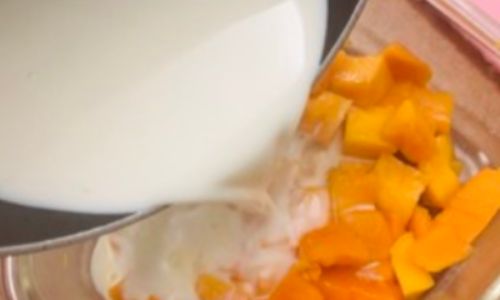Table of content
Pudding, a beloved dessert enjoyed worldwide, comes in countless varieties—creamy, custardy, fruity, or chocolatey. Whether homemade or store-bought, one question lingers in every pudding lover’s mind: How long can I keep this before it goes bad? The answer isn’t one-size-fits-all. Factors like ingredients, storage methods, and even the type of container used can drastically affect shelf life. This article dives deep into the science of pudding spoilage, offers practical storage tips, and equips you with the knowledge to enjoy your dessert safely.
Understanding Pudding’s Composition: Why Shelf Life Varies
Pudding’s longevity hinges on its ingredients. Dairy-based puddings (e.g., custard, rice pudding) contain milk or cream, which are perishable due to their protein and moisture content. These proteins act as a breeding ground for bacteria, making dairy puddings more prone to spoilage. Non-dairy alternatives, like chia pudding or those made with almond milk, may last slightly longer but still require refrigeration.
Store-bought puddings often include preservatives such as potassium sorbate or citric acid to inhibit microbial growth. Homemade versions, lacking these additives, typically have a shorter shelf life. Similarly, puddings with eggs (like crème brûlée) face higher spoilage risks due to raw egg content, which can harbor salmonella if mishandled.
Shelf Life Breakdown: By Type and Storage Method
Homemade Pudding
- Refrigerated: 3–4 days. Without preservatives, bacteria multiply rapidly. Always use airtight containers to prevent odor absorption and moisture loss.
- Frozen: 1–2 months. Freezing halts bacterial growth but may alter texture (e.g., cream-based puddings can become grainy). Thaw in the refrigerator and stir well before serving.
Store-Bought, Unopened
- Refrigerated: Check the “best by” date. Most last 1–2 weeks beyond this date if unopened, but quality may decline.
- Shelf-Stable (e.g., snack packs): 6–12 months unopened. Once opened, refrigerate and consume within 5–7 days.
Dairy-Free Puddings
- Refrigerated: 5–7 days. Ingredients like coconut milk or oat milk resist spoilage slightly longer than dairy but still require cold storage.
- Frozen: 2–3 months. Texture changes are less noticeable than in dairy puddings.
Baked Puddings (e.g., bread pudding)
- Refrigerated: 4–5 days. The egg and milk base demands prompt refrigeration.
- Frozen: 2–3 months. Reheat gently to retain moisture.
Signs Your Pudding Has Spoiled
Trust your senses, but err on the side of caution:
- Visual Cues: Mold (fuzzy spots in various colors), separation of liquids, or curdling.
- Odor: A sour, fermented, or rancid smell indicates bacterial activity.
- Texture: Unusual graininess, excessive thinness, or a “slimy” film.
- Taste: A bitter, metallic, or off flavor (discard immediately if this occurs).
Note: Even if a pudding passes the smell and taste test, consuming it past its prime risks foodborne illness. When in doubt, throw it out.

Proper Storage Techniques to Maximize Freshness
Refrigeration Basics
- Temperature: Keep your fridge at 40°F (4°C) or below. Higher temperatures accelerate bacterial growth.
- Containers: Use glass or BPA-free plastic containers with tight-fitting lids. Avoid metal, which can react with acidic ingredients (e.g., lemon pudding).
- Location: Store pudding on middle shelves, not the door, where temperature fluctuations are common.
Freezing Best Practices
- Portion Control: Freeze pudding in single-serving containers to avoid repeated thawing and refreezing.
- Texture Preservation: For creamy puddings, blend with a tablespoon of cornstarch before freezing to reduce ice crystal formation.
- Thawing: Never thaw at room temperature. Move to the fridge 24 hours before serving.
Handling Leftovers
- Avoid Cross-Contamination: Use clean utensils each time you serve pudding. Double-dipping introduces bacteria.
- Toppings: Add fresh fruit, whipped cream, or nuts just before serving to prevent sogginess.
Food Safety Guidelines: What the Experts Say
Organizations like the USDA and FDA emphasize the “2-Hour Rule”: Perishable foods left at room temperature (40–140°F/4–60°C) for over two hours should be discarded. This applies to pudding at picnics, potlucks, or buffets.
For vulnerable populations (pregnant women, elderly, children), the margin for error shrinks. Always prioritize freshness when serving these groups.
Extending Shelf Life: Creative Hacks and Tips
- Preservatives: Add a pinch of salt or a drop of lemon juice to homemade pudding to inhibit bacteria.
- Vacuum Sealing: Remove air from containers to slow oxidation and microbial growth.
- Repurpose Leftovers:
- Overripe pudding? Blend into milkshakes or use as a cake filling.
- Freeze in popsicle molds for a refreshing treat.
- Make-Ahead Mixes: Prepare dry ingredients (sugar, cornstarch) in advance and mix with milk just before cooking.
The Science Behind Spoilage: Bacteria and Enzymes
Pudding spoilage is a battle between your storage methods and microbial forces. Common culprits include:
- Pseudomonas: Causes sour odors and slimy textures.
- Lactobacillus: Converts lactose into lactic acid, creating a tangy taste.
- Molds (Penicillium, Aspergillus): Thrive in moist environments and appear as fuzzy patches.
Enzymatic activity also breaks down pudding’s structure over time, leading to weeping (liquid separation) or a chalky mouthfeel.
Debunking Myths: Does Pudding Ever “Go Bad” in the Freezer?
Freezer burn—dehydration caused by air exposure—can make pudding taste stale, but it’s not unsafe. To prevent it, press plastic wrap directly onto the surface before sealing containers.

Global Perspectives: How Culture Influences Shelf Life
In tropical regions, where refrigeration is less common, puddings like khanom thuai (Thai coconut pudding) rely on high sugar content and quick consumption. Conversely, Scandinavian riskrem (rice pudding) often includes whipped cream and is eaten within a day of preparation.
Eco-Friendly Tips: Reducing Pudding Waste
- Plan Portions: Use a pudding mold or ramekins to control serving sizes.
- Compost Spoiled Pudding: Organic waste can enrich soil (check local composting guidelines).
- Donate Excess: Local shelters may accept unopened, unexpired pudding cups.
Conclusion: Savor Safely, Waste Less
Pudding’s fleeting shelf life is a small price for its decadent taste. By understanding storage basics, recognizing spoilage signs, and embracing creative repurposing, you can enjoy every spoonful without risk. Whether you’re a from-scratch baker or a snack-pack enthusiast, treating pudding with care ensures it remains a treat—not a health hazard.
Next time you ask, “How long does pudding last?” remember: It’s not just about days on a calendar, but the harmony of ingredients, environment, and vigilance. Now, go forth and pudding-responsibly! 🍮





0 comments